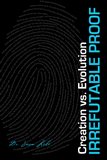History it Ain’t
AiG reviews the history channel TV documentary "Ape to Man."
There is one thing AiG can agree with regarding the new evolutionary documentary “Ape to Man” that first aired on The History Channel last Sunday (August 7) in America (and will be rebroadcast later today, August 11). It is the comment made by the program producers that a “compelling question in our history” is: where do we come from? (Which leads to the ultimately more important question, “Why are we here?” which the Bible addresses from Genesis to Revelation.) But that’s about all creationists have in common with the beliefs expressed by the TV program’s producers.
As someone holding two degrees in history (and possessing good knowledge of the fossil record), I know something about the difficulties in trying to reconstruct the past. It’s tricky business (sometimes it’s more nefarious … “monkey business” in some cases). For example, we have an argument even this week among historians about an event that occurred in relatively recent world history. I read an article yesterday which claims that the devastation of the atomic bombs dropped on Japan in 1945 (with the threat of additional bombs being dropped) was not the main reason the Japanese decided to surrender to end World War II, but rather it was the threat of Russian invasion from the west. If trained scholars today, with their access to mounds of information and even many eyewitnesses and decision makers, will strongly disagree on such a recent event, then trying to go back over the millennia to draw conclusions about man’s origins (typically based on fragments of bones) is a highly iffy proposition.
Words like “suggest,” “if,” “it is also believed” punctuate the TV program, as the apemen are built one speculative bone at a time. In the end, though, and employing just a little critical thinking, the thoughtful viewer is able to see that these apemen are instead really just straw men, created out of the minds of evolutionist scientists.
The program, which displayed more candor than others which promote the evolutionary worldview, admitted that the fossil record is built on the “tiniest fragments of the past.” At the same time, however, it confidently declared that the puzzle of human origins has been “finally pieced together.”
A summary of the program
As The History Channel’s website declares, “the search for the origins of humanity is a story of bones and the tales they tell. It was in 1856 that the first bones of an extinct human ancestor were encountered … Neanderthal Man.” The TV program, however, in contradicting the website, states that not only did Neandertals have a bigger brain than most humans and possessed a keener sense of smell, they were around during the time of modern humans, and so were not our ancestors. They are not a “true missing link” of an “extinct human ancestor.”
For a clearer rebuttal to Neandertal as being something of a brutish ancestor of ours, which is still paraded in the media and in school texts as one proof of molecules-to-man evolution, see .
Now, let’s see how long it will take the textbooks to catch up with this conclusion about Neandertal Man.
Soon after the discovery of the Neandertal bones, Darwin was on the scene with the publication of his famous 1859 Origins book and, as the channel’s web article continues, “by the end of the nineteenth century, it [evolution] had become the hottest topic of the age.” Over 100 years later, it remains one of the hot topics in America’s culture wars, as witnessed by this week’s cover story of Time magazine called “The Evolution Wars” (see our article Time for Evolution Wars).
The TV researchers did at least point out that the theories of scientists do change and that many scientists have been taken in (even with extreme gullibility) by such hoaxes as Piltdown Man (they were duped for decades [see The Piltdown Man Fraud]). Even this confession of scientists having been taken in by a hoax was used by the TV program to buttress the “human ancestor” claims of Raymond Dart and his Australopithecus find, which had been rejected for several years because the evolutionists had put their faith in Piltdown Man instead. For more on Dart, see The Taung Skull: ‘Missing Link’?
In “Ape to Man,” reenactments tell stories like those of the work of Eugene DuBois, a Dutch doctor who left his practice in the late 1800s in search of the “missing link,” and then while in Java, supposedly found an apelike “skeleton” (to use the word used on the website of The History Channel; it was hardly a skeleton, for only two bones, a part of a skull cap and a leg bone were found, which the program admitted was “meager evidence”). While the scientific world at the time (correctly) rejected DuBois’s conclusion that he had found the missing link, it was to be embraced later by the evolutionist community as a bridge between humans and an apelike ancestor. Read a creationist interpretation of this find at Who was ‘Java Man’?
A web critique of this speculative TV program could go on for many thousands of words (including how it recounted the famous “Lucy” find; see our rebuttal at “Lucy” isn’t the “Missing Link!”). We note that hardly anything was mentioned in the program about the accuracy of the dating methods used to assign dates to the alleged fossil finds.
For a full review of the fossil record of man, read Prof. Marvin Lubenow’s comprehensive book Bones of Contention. In the end, you will discover that the Bible, not the highly imaginative minds of TV producers at The History Channel, tells the true history of the world, including the origin of the first people (in Genesis 1).
Recommended Resources

Answers in Genesis is an apologetics ministry, dedicated to helping Christians defend their faith and proclaim the good news of Jesus Christ.
- Customer Service 800.778.3390
- © 2024 Answers in Genesis









